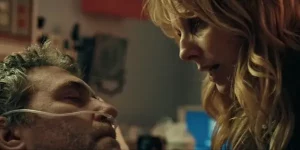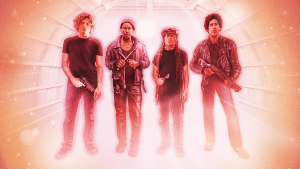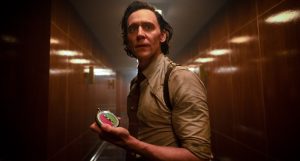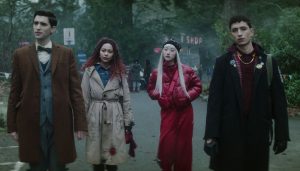
This article contains Alien: Romulus and The Flash spoilers.
The reviews are in, and some fans are already holding Fede Alvarez’s Alien: Romulus up as the best xenomorph feature since Ridley Scott’s 1979 original and James Cameron’s Aliens from 1986. It feels like a new era of the Alienverse is ready to burst forward from Hollywood’s chest. But while there’s plenty of praise for Alvarez’s back-to-basics approach, which tries to capture the pulse-pounding horror of Scott’s Alien, it’s not quite a perfect outing.
As well as some criticizing the suitably batshit ending that echoes Alien Resurrection’s bewildering finale, it’s the return of Ian Holm’s likeness that’s causing a stir for Romulus—namely because the actor tragically passed away in 2020. Despite a CGI approximation of “Holm” appearing in the role of a new android called Rook instead of Alien‘s Ash, it isn’t immediately clear this is a new character. Maybe it’s because I was too distracted by the return of a dead actor or maybe it’s the jarring uncanny valley effects, but unlike Michael Fassbender playing David and Walter in Alien: Covenant, it’s all a bit distracting. Worse than this, Alien: Romulus is the latest big movie (but undoubtedly not the last) to resurrect a beloved actor for what feels like cheap fan service. From Star Wars to Ghostbusters, what is the deal with these major franchises bringing dearly departed actors back from the dead?
You might remember when another Ridley Scott-adjacent project grabbed headlines after Blade Runner 2049 controversially created holograms of Elvis Presley, Marilyn Monroe, and Frank Sinatra. But that was a little easier to process since the uncanny valley aspect of their appearance was the intentional point in the Denis Villeneuve sequel. They were also intended to be almost throwaway easter eggs.
Conversely, when it came to Rogue One: A Star Wars Story, the extended screen time of an uncanny valley version of Peter Cushing crossed into concerning territory. After all, the actor had passed away in 1994, and while the casting department sought out Guy Henry, who already looked a lot like Cushing, an unnerving digital likeness of Grand Moff Tarkin was superimposed on Henry’s face. Similarly to Romulus, Rogue One is a fan-pleasing movie that feels tarnished by these deep fakes taking us out of the action.
Star Wars is arguably the worst offender in this phenomenon. The series struggled to decide what to do with Princess Leia following Carrie Fisher’s death in 2016, although it’s easy to be more sympathetic to Leia’s return in Star Wars: The Rise of Skywalker, especially with Fisher’s own daughter (Billie Lourd) playing the digitally de-aged Leia. The same can be said for Paul Walker’s brother, who stood in for him in Furious 7 in order to bring back Brian O’Conner for one last ride. Even as far back as 1999, Ridley Scott was himself resurrecting actors back from the dead with stand-ins and computer composites finishing up Oliver Reed’s performance as Prixmo after the actor died during the filming of Gladiator. Struggling to replace an actor and honoring their legacy is one thing, but there’s a much murkier side to this movement.
It’s often a struggle to see why you’d include a dead actor when there’s little need to bring that character back. 2006’s Superman Returns used CGI to recreate Marlon Brando’s Jor-El two years after the actor’s death and 26 years, and after his scenes were cut from Superman II. Theoretically it informed the plot of that movie, which was intended to be a sequel to Superman II, yet it seemed to knowingly be desecrating hallowed ground. The film’s villain even smirks “he’s dead” when looking at Brando’s image.
More recently, The Flash was rightly lambasted for bringing Christopher Reeve back from the dead. In fact, Andy Muschietti’s movie is one of the most egregious examples of using CGI to resurrect dead actors. The likes of Reeve, George Reeves, and Adam West were all featured, and more than just fans hated the “Chronobowl” scene for its lackluster visuals. And it was frankly disquieting to hear Reeve’s own children tell Variety they hadn’t watched it and had no involvement.
There’s also Ghostbusters: Afterlife (which was already called out as a movie that didn’t really need to exist), memorably featuring cameos from the OG gang. Following Harold Ramis’ death in 2014, bringing him back as a literal ghost didn’t sit well with some audiences, but I’d argue if there’s any franchise you’re going to do it, Ghostbusters is just about acceptable. Thankfully, Ghostbusters: Frozen Empire learned from these mistakes and decided not to bring back Egon’s ghost for another sequel. It at least seemed more thematically poignant for the story Afterlife was trying to tell, with its focus on Egon’s grandchildren, than Holm’s return in Romulus. Other critics have already pointed out it would’ve been easy to use someone like Michael Fassbender’s David or to even de-age the beloved Lance Henriksen and bring in a variant of the fan-favorite Bishop model 341-B synthetic.
But then, that aforementioned de-aging has also become a popular trend with its fair share of problems. It might’ve been novel seeing a de-aged Robert Downey Jr. pop up as young Tony Stark for a scene in Captain America: Civil War, but when it came to Martin Scorsese’s The Irishman, the much younger depictions of Robert De Niro, Joe Pesci, and Al Pacino took plenty of viewers out when it was used for more than half of a four-hour movie. It’s all the more frustrating when you realize the legendary Star Wars visual effects house, ILM, led The Irishman’s effects development.
I doubt The Godfather, Part II would be regarded as the best in the trilogy if we’d de-aged Brando instead of casting De Niro as a young Vito. As with Romulus’ depiction of Holm being an obvious dupe, these movies are in danger of aging like the schlocky CGI of the Scorpion King in The Mummy Returns.
We’re getting a taste of that future throughout ILM’s Star Wars work though, especially since that franchise began opting to use a de-aged Luke Skywalker. Even though Mark Hamill might be hard to replace, imagine if Solo: A Star Wars had de-aged Harrison Ford instead of casting Alden Ehrenreich. The worst part is the actor who played the flesh version of young Luke in The Book of Boba Fett is a dead ringer for a young Hamill. As well as not looking great, de-aging actors and bringing back the dead feels like it’s robbing others of a chance to join these major franchises. If George Lucas made his Star Wars prequels today, would he have resurrected Alec Guinness instead of casting Ewan McGregor playing a young Obi-Wan? It would have denied us one of the saga’s greatest performances.
Still, unlike Reeve in The Flash, at least Holm’s widow was consulted on Romulus. Speaking to The LA Times, Alvarez defended the use of his likeness and explained, “We were not trying to do what can’t be done, which is to reproduce that person’s talent as an actor, because this is another character…The only thing they have in common is the likeness.” Yet with British actor Daniel Betts doing the facial capture and AI helping with the voice, it feels like a disservice to bring Holm back in this way. Unfortunately, we can’t ask the man himself what he thinks of Romulus.
It feels like we’re on the cusp of seeing these kind of unsettling visual effects a lot more. The BBC reports that WRX and its sister company have the licensing to hundreds of deceased celebrities, including James Dean, Rosa Parks, Malcolm X, and more. Video game voice actors, including Mass Effect‘s Jennifer Hale and Metal Gear’s David Hayter, have been vocal about the potential of AI putting them out of work, and saying things they wouldn’t in real life. Meanwhile Susan Sarandon told The Hollywood Reporter it’s a “now or never situation” in terms of AI taking over.
The Thelma & Louise actor mused, “It scares me if it means taking someone’s image, using it in perpetuity in any film you want without the actor having control anymore. Going in this direction, I don’t know if we should copyright our voices or ourselves.” Sarandon might be against the idea, but if her estate signs off on it after her death, there isn’t a lot she can do about it. I’m reminded of the fact that Guinness’ reportedly hated playing Obi-Wan Kenobi and can only imagine him turning in his grave if his estate signed up for a CGI recreation of him so many decades after his death.
Perhaps the only thing stopping this Blade Runner-inspired AI takeover is the expense. Alvarez admits that it would’ve been much cheaper to hire an actor than go to the trouble of trying to recreate Holm, but that doesn’t seem to be a reason to stop Hollywood from capitalizing on the trend. The BBC reported in 2023 that generative AI is due to expand James Dean’s tragically short film catalogue with a sci-fi road trip called East of Eden, while some have started referring to this movement in a derogatory way as a ‘Tarkin.’
Rogue One might be remembered as the one that kickstarted the trend, but as Romulus and more get embroiled in the drama, it takes the shine off what are otherwise stellar love letters to a franchise’s past. If you think seeing Audrey Hepburn brought back from the dead to sell Galaxy and Dove chocolate bars is bad, chances are it’s going to get a lot worse.
The post From Alien to Star Wars: The Problem with Bringing Back Dead Actors appeared first on Den of Geek.






